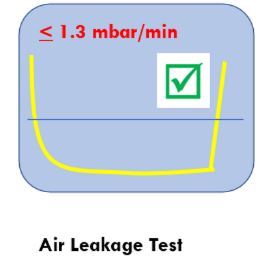0 Air Leakage Flow Rate Test
- Autoclave Validation
- by Kevin Peacock
- 24-07-2024

The air leakage test is used to demonstrate that the quantity of air leakage into the sterilizer chamber during periods of vacuum does not exceed a level that will inhibit the penetration of steam into the sterilizer load and will not be a potential cause of re-contamination of the sterilizer load during drying.
ISO 17665:2024 - Annex C.6
Introduction
The vacuum leak test is applicable to any sterilizer which employs vacuum to remove air from the load, such as a porous load sterilizers and some fluids sterilizers.
Leakage of air into the chamber at a rate greater than that specified below is unacceptable for the followings reasons:
- the presence of air inhibits penetration of the load by the sterilant and prevents sterilization;
- air leaking into the chamber during the drying and air admission stages will not have passed through the bacteria-retentive filter, and therefore there is a risk of recontamination of the load;
A vacuum leak test is required to establish that permissible limits are not exceeded.
The test is performed by measuring the change of vacuum in the chamber when all valves leading to it have been closed and the vacuum source isolated.
NOTE- If the test is conducted as part of a programme including thermometric tests, it will be necessary to repeat it with the temperature sensors and any test pressure gauge in place, and again when they have been removed, to ensure that there is no leakage through the ports.
The test should be performed with an empty chamber.
If the sterilizer is not fitted with a vacuum leak test instrument, connect a 0-160 mbar absolute pressure gauge to the chamber.
For the test to be accurate, the chamber temperature should be stable. For example, in a closed vessel at 40 mbar absolute, the pressure changes by approximately 1 mbar for each 10°C change in temperature over the range 20-140°C. At 70 mbar the change is approximately 2 mbar. The test could be compromised if the temperature changes by more than 10°C during the period in which the chamber pressure is monitored. Stabilise the temperature of the chamber by one of the following methods:
- If the vessel incorporates a heated jacket, carry out an operating cycle with the chamber empty;
- If there is no heated jacket, ensure that the temperature of the chamber is no greater than 20°C from ambient.
When the temperature has stabilised, start the vacuum leak test cycle. For automatic systems the following steps are performed automatically, and the vacuum leak rate is displayed as a pressure rise in mbar min-1. For semiautomatic systems, the pressures should be read and noted by the operator.
When the pressure in the chamber drops below 50 mbar absolute close all the valves connected to the chamber and stop the vacuum pump. Note the time and the absolute pressure (P1).
Wait for 5 minutes (± 10 s), and then note the pressure again (P2).
Wait for a further 10 minutes (± 10 s), and then note the pressure for a third time (P3).
Restore the operating cycle and allow it to proceed normally.
Calculate the vacuum leak rate for the 10-minute period from:
Vacuum Leak Rate = (P3-P2)/10mbar min-1
For chambers with a capacity of 250-600 I, the test should be considered satisfactory if the following requirements are met:
- the absolute pressure (P2) at the start of the 10-minute period is:
- less than 70 mbar for porous load sterilizers;
- the vacuum leak rate does not exceed:
- 1.3 mbar min-1 for porous load sterilizers and laboratory sterilizers;
For chambers outside the range 250-600 I, the test should be considered satisfactory if the pressure P2 and the vacuum leak rate are as specified by the manufacturer.
Considerable care must be applied in the interpretation of the results of leak tests. On a typical test on a porous load sterilizer the pressure may rise by 20 mbar or more (P2 – P1) in the first 5 minutes of the test due to the evaporation of moisture remaining in the chamber and connecting pipework. Such a result does not necessarily indicate a leak.
A machine which fails to meet the requirements of this test should not be used until the fault has been rectified and the test satisfactorily completed.
Return to Schedule of Tests
